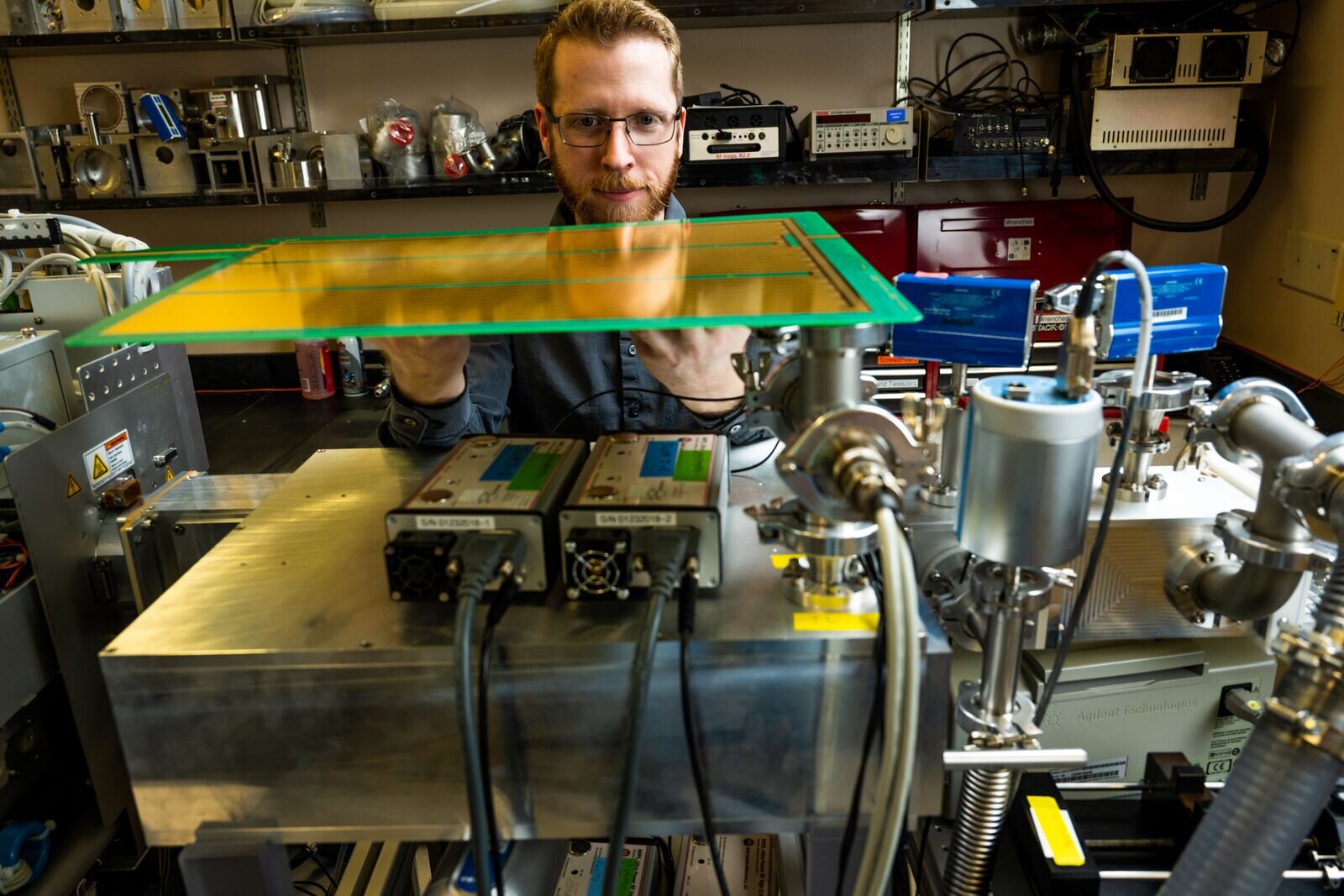The universe is full of billions of possible chemicals. But even with a group of high-tech instruments, scientists have been able to determine the chemical structures of only a small fraction of those compounds, perhaps 1%.
Scientists at the Department of Energy’s Pacific Northwest National Laboratory (PNNL) are aiming for the other 99%, creating new ways to learn more about a vast sea of unknown compounds. There may be cures for disease, new strategies for dealing with climate change, or new chemical or biological threats lurking in the chemical universe.
The work is part of an initiative known as m/q, or “m over q”—shorthand for mass divided by charge, which indicates one of the ways scientists measure chemical properties in the world of mass spectrometry.
“At the moment, we can take a sample from the soil, which, depending on the type of soil, may contain thousands of chemical compounds in the amount of just one teaspoon,” said Thomas Metz, who heads the m/q Initiative. “And we don’t know what most of them are in terms of their chemical structures. We just have no idea what’s inside.”
Scientists typically rely on reference libraries containing information about thousands of molecules to identify substances. Researchers sort their samples from the soil, the body, or anywhere else and compare what they measured experimentally with what’s in the library. While that helps, it limits scientists to structurally determining only molecules that have been seen before—for example, by analyzing standard compounds purchased from chemical suppliers.
In the latest development, a team led by scientist Adam Hollerbach has combined two high-resolution instruments into one system to measure molecules in unprecedented detail. The results were published on June 12 in the journal Analytical Chemistry.
Today, scientists can make several important measurements about chemical compounds in one experiment, obtaining important information faster, more conveniently, and more accurately than ever before.
Hollerbach’s method applies to ions—molecules that have a positive or negative charge. That makes them easier to control and potentially detect using mass spectrometry.
Mass spectrometry: Tool of ion whisperers
Like the people who study them, ions have many features that distinguish them from one another. In humans, weight, hair color, size, shape, eye color, and many other characteristics help us know who we are. For ions, identifying properties include mass, shape, size, electrical charge, and chemical composition. Those serve not only as identifiers but also as guides to the behavior of related molecules—clues to their potential to cure disease or ward off pollutants, for example.
That understanding should aid the efforts of scores of scientists at PNNL focusing on understanding the impact of microbes on climate. Microbes play an important role in transforming elements like carbon into other forms that are important for the planet. Their effect on warming or cooling the planet is very strong. But scientists have a lot to learn.
“There can be millions of microbes in just one gram of soil, and we don’t know who most of them are or what they do. There’s still a lot of discovery to be made,” Metz said. “From a challenging science perspective, this is either a worst-case scenario or one of our best opportunities, depending on how you look at it.”
The m/q scientist seizes the opportunity. Instead of framing their questions within the relatively small number of compounds that can be identified with conventional mass spectrometry measurements, they attempt to leapfrog current limitations and create an entirely new method of determining whether what is not known now. It’s a bit like when a new telescope is deployed and reveals a few distinct stars where before, a dim hodgepodge of celestial bodies was visible.
The work is both experimental, putting molecules through their paces in the laboratory, and on computers, where scientists model what they see and predict what they’re likely to see.
In the experiments described in Analytical Chemistry paper, Hollerbach and colleagues made sensitive measurements of peptides and lipids. The experiments combined two instruments that have similar names but provide different details about the ions. Both are used in mass spectrometry, a field whose history is intertwined with the discoveries of PNNL scientists.
The first instrument is a mass spectrometer, which measures an ion’s mass, electric charge, and how the ion splits. In this study, the team used an Orbitrap developed by Thermo-Fisher Scientific. Such instruments sort molecules of different masses, but two molecules of the same mass are difficult to separate. Think of two people, each weighing 180 lbs.—one tall and thin while the other is short and stocky. In one dimension alone, they are impossible to separate.
A SLIM approach: Ion mobility spectrometry yields compelling results
The second instrument is known as SLIM: structures for lossless ion manipulations. SLIM, developed by PNNL scientist Richard D. Smith and colleagues, is an ion mobility spectrometer that measures ion size and electric charge.
SLIM, which is about the size of a laptop and only a quarter of an inch thick, is a hothouse of molecular activity. Dozens of long, winding paths transform the tiny device into a 42-foot-long molecular racetrack, with ions tightly controlled by electric fields that spin around an oval obstacle. course.
The “obstacles” are other, known molecules such as helium or nitrogen molecules. As the ions being studied run through the SLIM device, they navigate around or through other molecules, bouncing and spinning like a football running back running in and around opposing blockers. . The term “ion mobility spectrometry” really captures the action.
By recording how long it takes the ions to complete the course—how quickly they navigate through blocking ions—scientists learn all sorts of things about the ions’ shape and size. That information, not available from a standard mass spec instrument, is combined with data about the ion’s mass, electric charge, and fragmentation pattern. Altogether, the data yield the ion’s collision cross section, its molecular formula, and its fragmentation pattern, properties that are important to understanding the structure of a molecule.
“Two different molecules can have the same number of atoms, and the same mass and charge, but they can have different structures and activities. That’s where SLIM comes in to tell the difference,” Hollerbach said. “Just one small change can mean the difference between a molecule that signals a disease and one that doesn’t.”
The key to Hollerbach’s experiment was getting two different instruments to play well together. While both standard mass spectrometry and ion mobility spectrometry analyze ions, they operate on different time scales. The ions make their journey through the SLIM and reach the Orbitrap faster than they can be processed.
So Hollerbach used an old technique, deploying “dual-gated ion injection.” He added gates to control the intake of ions into the system and to control their arrival at the Orbitrap, choosing to send some of the ions from SLIM into oblivion to keep the flow at a manageable rate.
“Really, the questions we’re asking are very simple,” Hollerbach said. “What is it, and how much is there? But the methods we use are complicated.”
Other m/q scientists are developing additional methods to identify or exploit unknown molecules. Some are working on ways to use data like that from Hollerbach’s experiment to automatically predict the structure of an ion, so drugmakers and other scientists know exactly what they’re doing. Others sift through the millions of possibilities for forms of compounds like fentanyl, sorting what’s unlikely from what might one day hit the street. They then predict how those compounds will behave inside the mass spectrometer—creating a way to detect them if and when they appear.
Additional information:
Adam L. Hollerbach et al, A Dual-Gated Structures for a Lossless Ion Manipulation-Ion Mobility Orbitrap Mass Spectrometry Platform for Integrated Ultra-High-Resolution Molecular Analysis, Analytical Chemistry (2023). DOI: 10.1021/acs.analchem.3c00881
Journal information:
Analytical Chemistry
#mass #spectrometry #combo #offers #promise #tapping #natures #unknown #chemical #universe















Add Comment